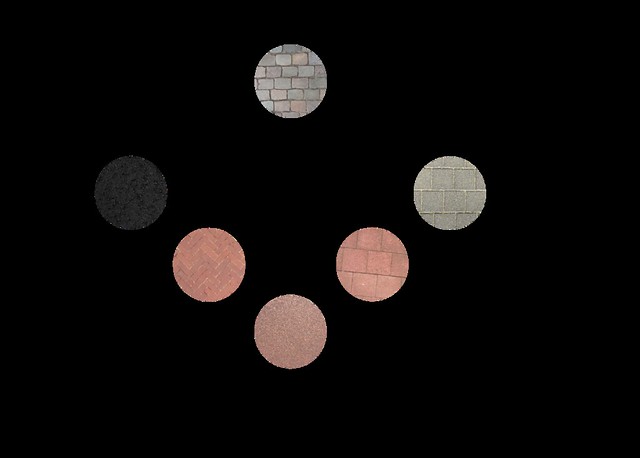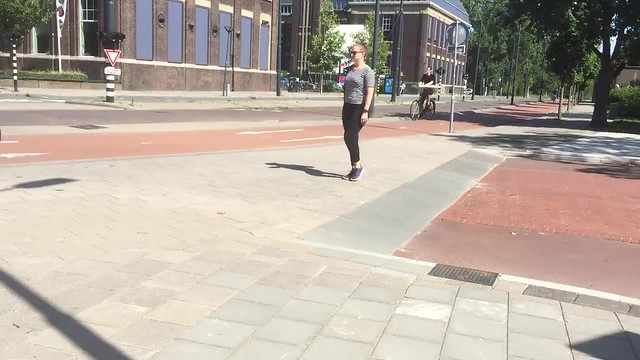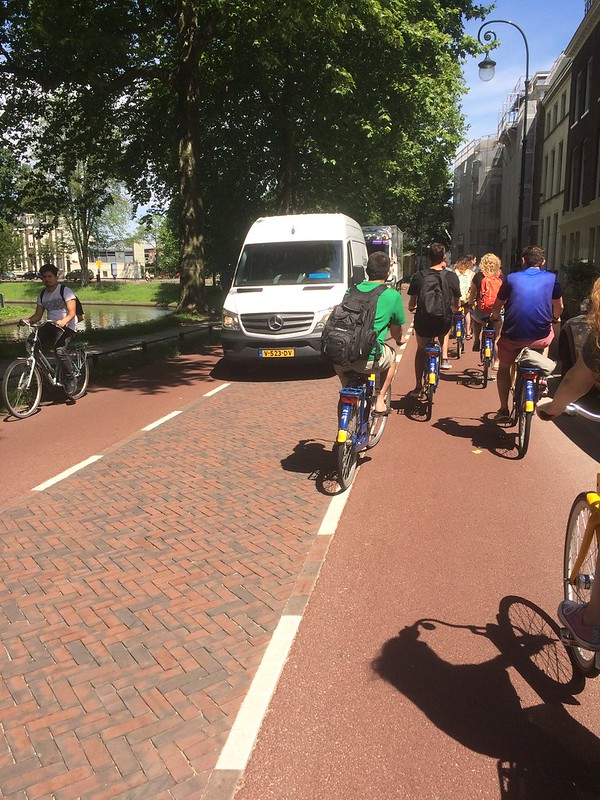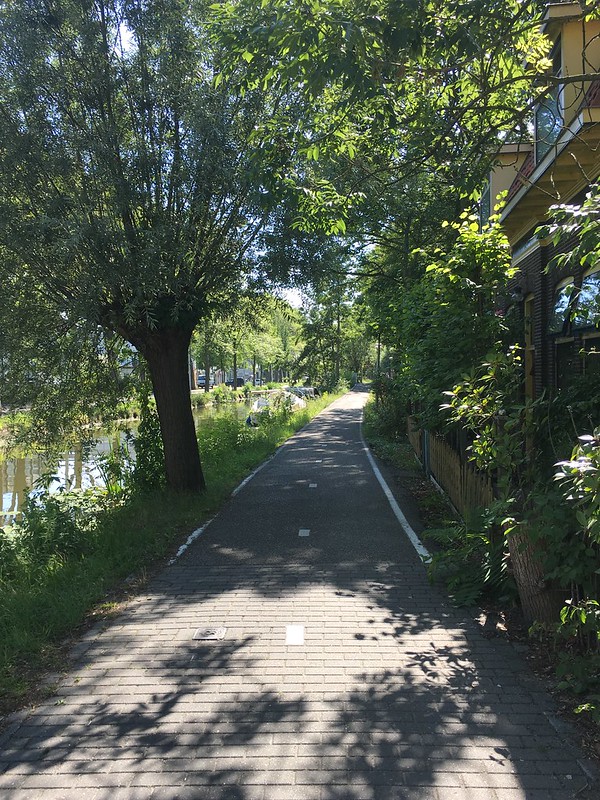3.1a A street’s look and feel conveys meaning
Alison Lunny and Ramzi Talhouk
Introduction
In order for a road to be sustainably safe, every different type of road must be recognizable. Every user must know immediately the part of the road they must use and what to expect from others. In the Netherlands, on higher speed roads, cars drive on black asphalt, bikes ride in red areas, and pedestrians walk on grey sidewalks. This basic formula is then manipulated to draw attention to certain at-risk areas like intersections or crossings and alert drivers of potential bikers or pedestrians. In America, we mostly design for all black asphalt roads for cars, concrete sidewalks, and on rare occasions, painted bike lanes. This means that for a lot of the time bikers have to share the road with cars, while pedestrians must cross the street at road level, with only paint and road signs alerting cars of their presence. Such a road is shown below, Tremont Street in Boston. America is very sign-heavy and as much as we would like drivers to obey the signs, they often do not. Transportation engineers in the Netherlands recognize that road signs are often disregarded, so it is their job to effectively and immediately communicate to road users their expected behavior and make them wary of vulnerable areas without relying on road signs. This recognizability and effective communication happens when road materials are used for the same purpose in over and over; in many areas and circumstances. Emulating the Dutch’s use of recognizable road materials and adopting them into our own roads would make travelling safer for pedestrians and bikers in the United States, the most vulnerable users that need protection from cars.
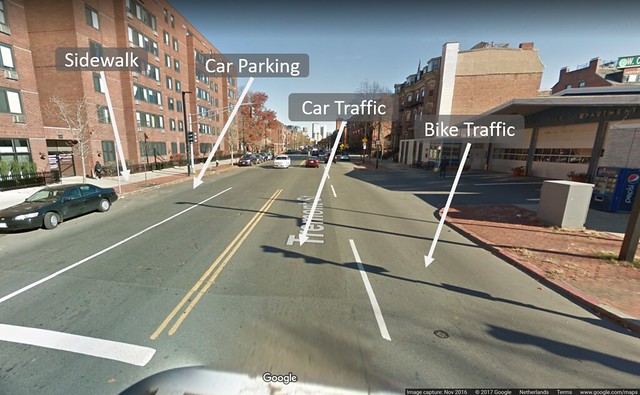
https://goo.gl/maps/BA3FD5MhLey
Materials Overview
Pictured above is our “material palette” of sorts, which shows all the types of pavement that the Dutch commonly use in their roads. The materials are separated by the type of road user that is ubiquitously expected traveling on them in the Netherlands. The three main categories of road users are cars, bikes, and pedestrians. The primary material used for cars is black asphalt, bikes use red asphalt, and pedestrians usually have some sort of grey tile walking space. Cobblestone is apart from the rest of the materials because it is meant to have no road users on it at all.
Everywhere, including the in the United States, it is understood that smooth black asphalt means the road is suited for cars and allows them to drive quickly. In the Netherlands, however, there are other materials that have become as societally linked with a type of road user as black asphalt is to cars. The goal for including these different materials is to ensure that all road users know where on the road they are to travel, thus increasing recognizability and predictability on roadways. This is one of the key principles of systematic safety according to the Dutch.
In the Netherlands, it is understood that the color red means bikes, everyone knows it, despite the fact that colored pavement on its own does not legally give priority to bikes in any way. Cars know red asphalt or brick are the most commonly used materials for bike lanes and cycle tracks, so they are prepared for encounters with cyclists whenever approaching red pavement. Brick roads also provide an additional physical reminder (the road is no longer smooth) to alert the drivers that they entered a different type of road and should thus behave differently. Namely, brick roads alert drivers that they are meant to slow down as brick roads often have lower speed limits and are used for more local streets. Therefore, when on brick roads, drivers are more prepared to encounter local traffic such as bicycles and pedestrians. However, bricks are more expensive to lay down in roads, so a cheaper solution used is to stamp red asphalt.
In America, especially on the East Coast, concrete pavement means sidewalk. In the Netherlands, tiles are the commonly used material for sidewalks (likely because they are easier to tear up and replace should utilities need maintenance under the sidewalk). However, sometimes on older streets or woonerfs, tile sidewalks are omitted. Instead, sidewalks are sometimes outlined only with a change in brick pattern (see photo). However, one would be hard-pressed to find a street with no visual separation between pedestrians and cars.
https://goo.gl/maps/VKLiJ2rHp532
Cobblestone is not designated specifically for cars, bikes or pedestrians. The purpose of cobblestone is to make certain areas uncomfortable to travel on for everyone, so users will only use it if they have to. This design is especially useful for areas like mountable medians and shoulders.
Another element to road material is vertical separation. There are three types of curb styles, graduated, soft, and hard. A graduated curb is a slope intended to alert a road user that they are entering a new area, and to bring certain sections of the road up to the same level as another. A soft curb is mountable, but feels a lot harder to get over. These are frequently used when bikers need to go up onto the sidewalk to park their bikes because the bicyclists can get to where they need, but it discourages them from biking on the sidewalk. Hard curbs are used when two areas shouldn’t encroach on another’s space, and therefore it is the hardest to mount because of the 90 degree angle of it.
Combinations
Bicycle Right-of-Way
Materials: Red Asphalt, Black Asphalt, Road Striping
Intersections like this can be found all over the Netherlands. Pictured here is the corner of Jaffalaan and Mekelweg in Delft, on the border of the TU Delft campus. This two-way cycle track is part of a very popular bike route connecting the TU Delft campus to the center of Delft. Due to its popularity, it is given priority over car traffic at this intersection. This priority is indicated not only by signage, but also the pavement treatments. The red pavement continuing through the road immediately alerts drivers of the presence of bicycles. Additionally, sharks’ teeth and arrows perpendicular to the direction of car travel seem to almost cut off approaching vehicles and further stress bikes’ right-of-way. Also included is a video showing the desired behavior at this type of intersection. The car approaching the intersection yields to bicycles coming from their two-way cycle track, which gets priority.

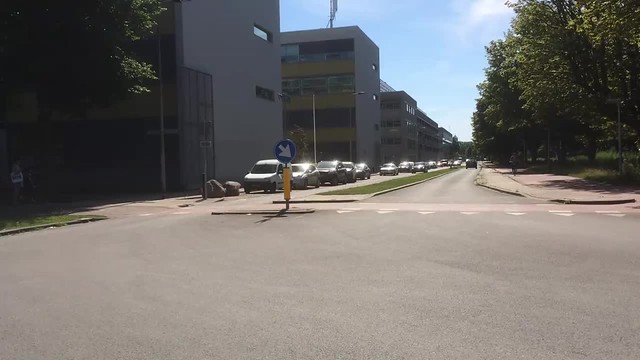
https://goo.gl/maps/GZM3FRjRkL72
Car Right-of-Way
Materials: Black Asphalt, Red Asphalt, Road Striping
Just like how knowing where bikes have the right-of-way is important, knowing where the cars do is too. This is done basically in the inverse way bike right-of-way is distinguished—with black asphalt going through the intersection and the sharks teeth pointing at bicyclists. This break in the bike’s path and recognizability of a black road gives them a notification to stop and yield to cars, like how cars have to for bikes when the red continues through the intersection.
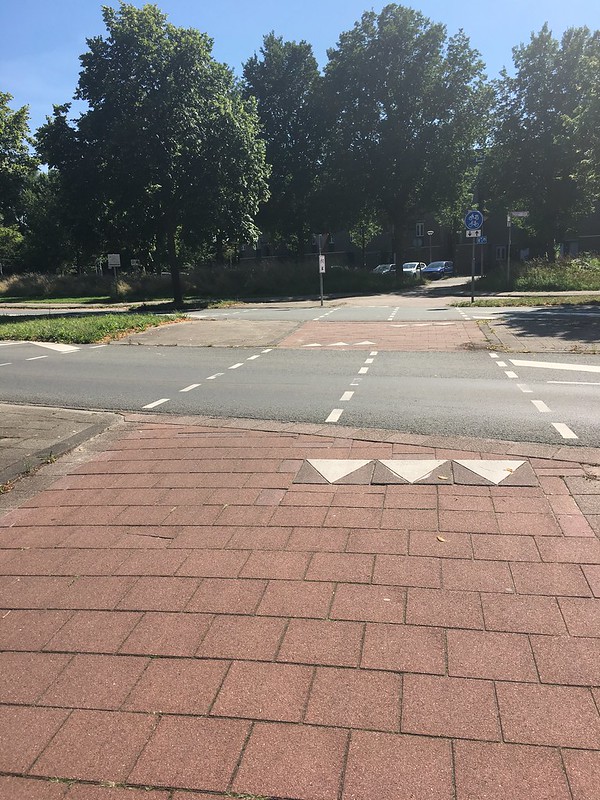
https://goo.gl/maps/C9eE3NXebLC2
Bicycle Street (Fietstraat)
Materials: Red Asphalt
In the Netherlands, the concept of the bicycle street (or “fietstraat” in Dutch) is one that is growing in popularity. A fietstraat, legally, is no different to a normal road. However, they are meant to serve as major bike routes, on which cars are allowed to drive as long as they behave as guests. The Dutch have realized that in order to make this concept a reality, they must go further in changing the roadway than just posting a few signs.
There are several ways in which Dutch planners turn a road into a fietstraat. Pictured above is one of the simpler, yet more effective methods. Namely, the designers made the entire road look like one large bike lane. Red pavement is so ubiquitously used to represent bicycle lanes and paths that cars instinctively know to watch out for and yield to bikes in red pavement; and at the same time, bicyclists feel they are in charge in red pavement. Therefore, paving this road red has turned it into a low-stress bicycle route into the town of Rijswijk from Delft. We would like to note that the Google Street View is not entirely updated, so this road was brick in August 2016, when the latest street view was taken
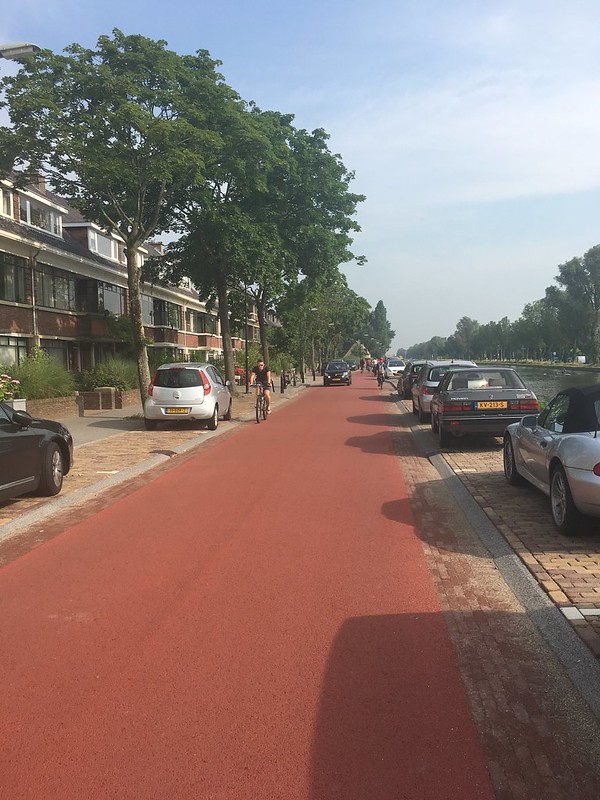
https://goo.gl/maps/aXfjHCh3VrE2
Neighborhood Intersection
Materials: Black Asphalt, Red Asphalt, Red Brick
In the United States, it is standard practice to lower sidewalks down to street level for intersections. Often times, this is a sufficient method, especially at signalized methods. However, in the Netherlands, a different approach is taken at local intersections. Instead of bowing the sidewalk, the street is raised to sidewalk level. This immediately sends a message to car traffic that they are entering someone else’s territory. Not only is the intersection raised, but the pavement material also changes. In the example pictured here, drivers go from driving on black asphalt to bricks, which, as stated above, drivers associated with lower speeds and encounters with pedestrians. This makes them proactively prepared for the pedestrians and bicyclists they will likely see crossing the street at the intersection.
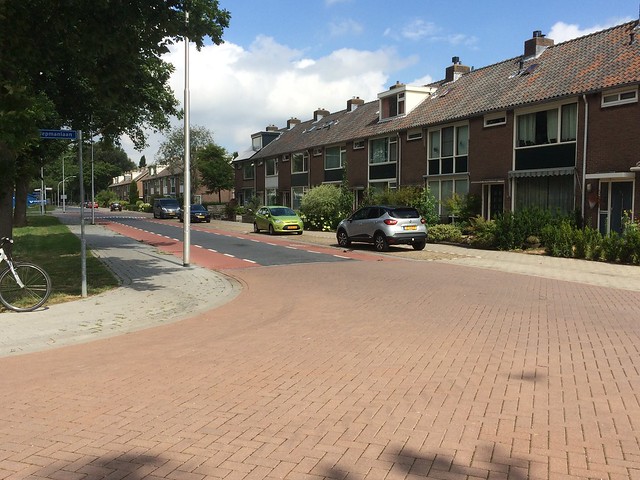
https://goo.gl/maps/5Uj5vmgWhyo
Driveway-Style Intersections
Materials: Black Asphalt, Red Asphalt, Brick, Tile
The Dutch have also come up with innovative ways to signal to drivers when they are entering a new type of road, on which their behavior must change. The main method to accomplish this is known as a driveway-style intersection or driveway construction. This strategy makes the street look like the sidewalk so that pedestrians feel completely safe and cars recognize they are in another road user’s territory. Pictured to the right is the intersection of Michiel de Ruyterweg and Julianalaan in Delft. At this intersection, Michiel de Ruyterweg serves as a local collector/distributor road, and is also one of the few roads that brings cars to the TU Delft campus. On the other hand, Julianalaan, on the block in question, is a small residential street. On the larger distributor street, the speed limit is 50 km/hr and cyclists stay out of the roadway on separated cycle tracks. However, on the smaller street, which has a speed limit of 30 km/hr, cycle traffic travels in bike lanes on the roadway. It is therefore very important that cars behave differently on these two streets in order to ensure safety for all road users.
Note: The Google Street View for this intersection has not been updated since August 2016, so this intersection on Street View is not the same as the current one.
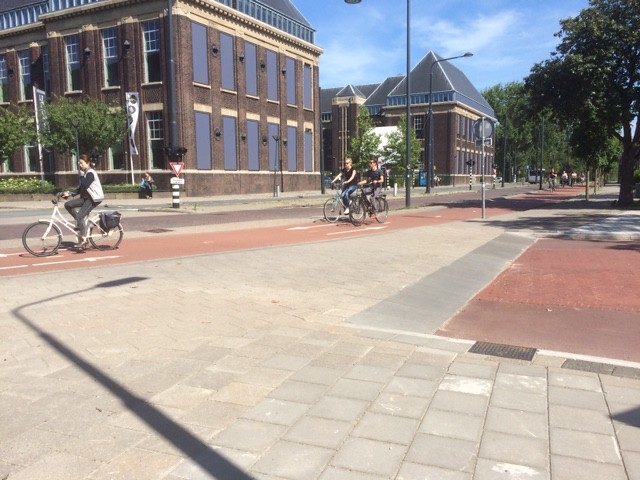
https://goo.gl/maps/eUjWrNWpSio
As is consistent with driveway-style construction, cars turning off of Michiel de Ruyterweg must mount a ramped curb in order to enter Julianalaan. In this case, the pavement material also changes when the curb is mounted, going from black asphalt to tile, on which cars know to look for pedestrians. Cars must also cross a red asphalt cycle track; the red asphalt along with long white lines that almost seem to block the car’s path, indicate that bike have priority in this new zone. And even after car drivers cross the pedestrian and bicycle zone, they dismount the curb onto red brick, a material that nearly always indicate small, local streets or even woonerfs.
The desired behavior can be seen in the video shown above. In the video, a car is trying to leave Julianalaan and turn onto Michiel de Ruyterweg. As soon as the driver approaches the driveway construction, he recognizes that he is mounting a sidewalk and therefore yields to passing bicycles. After waiting a moment, the driver spots some pedestrians who need to pass. As he recognizes he is intruding on a tile sidewalk, the driver reverses back onto Julianalaan to let the pedestrians pass on their own territory.
Service Roads
Materials: Brick, Tile
Service Roads serve as a good way for streets to serve multiple purposes. They are smaller roads parallel to through traffic that can be lined with parking, houses, or businesses. These service roads tend to have mixed traffic and a speed limit of 15 km/hr. In order to indicate this to drivers, service roads are often paved in brick, which is less comfortable to drive and cycle on than smooth asphalt. This slows drivers down and keeps them aware that bicycles and pedestrians may be on the roadway. The service road pictured here is no exception, it is paved with wire cut bricks and tile sidewalks. These two pavement types are synonymous with mixed traffic and sidewalks respectively.
https://goo.gl/maps/MVMrFuoh76m
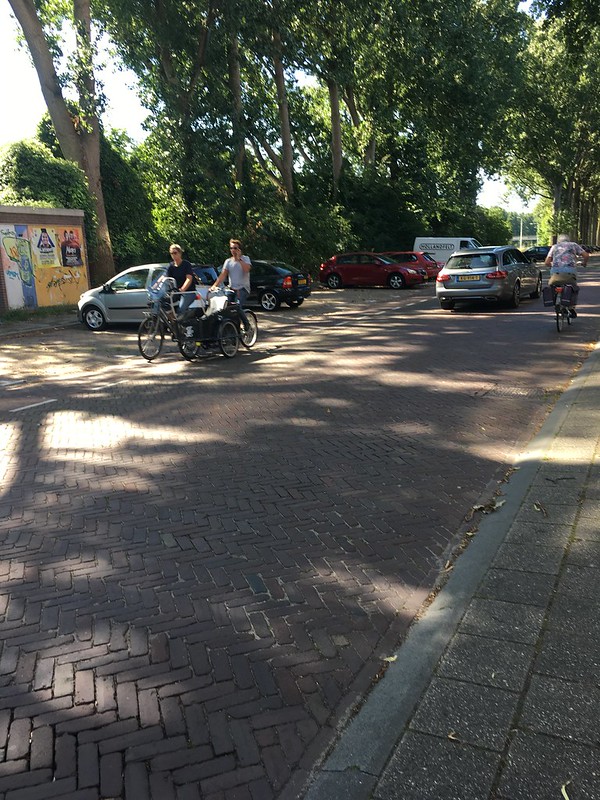
[13b]
Bus Rapid Transit Lanes
Material: Red Asphalt
A bus rapid transit line in the Netherlands is a public bus system that has its own lanes free of cars. In the picture, taken on Blitstraat in Utrecht, there are two BRT dedicated lanes (the silver car in the bus lane is a taxi and is also permitted in the dedicated lanes) free of normal traffic so the buses behave like trams, just with rubber tires instead of steel wheels. This system allows for reliable and frequent public transportation without placing down steel tracks.
The rapid transit lanes are both raised and red, so that drivers do not mistake the area for their own. While red normally means bikes, the bicycles have their own two way cycle track on the other side of the parked cars, so there is no room for confusion.
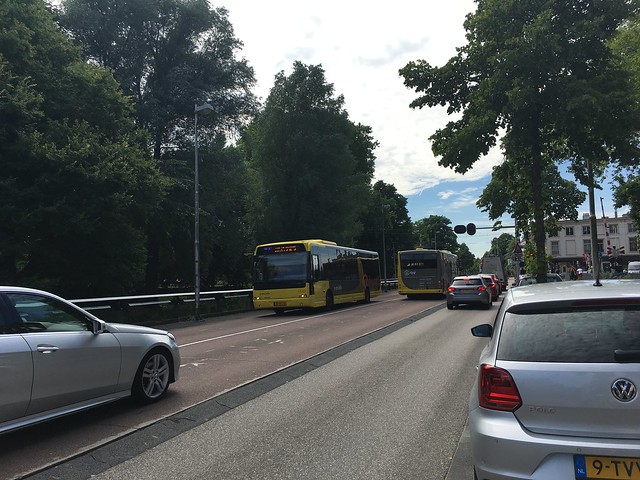
https://goo.gl/maps/eoC3QPjCfz52
Advisory Lanes
Material: Red Asphalt, Black Asphalt
Advisory bike lanes are put in roads where the road is not wide enough to have the car travel lanes along with bike lanes. So Dutch road designers make these red asphalt, full-width bike lanes with dashed lines bordering the car (black asphalt) area, so when the car feels like it needs to move over to avoid being in another road user’s way, it can check for bikers then dip into the lane. The reason why advisory lanes are so safe is because of the recognizability of the bikers’ space. Cars know to look for bikes in the red areas, so they do. When bikes are in mixed traffic, cars may not fully expect there to be a biker on the road, increasing the risk of the biker being hit.
Of course, advisory lanes don’t have to follow the black asphalt for cars + red asphalt for bikers formula. Engineers can continue adding layers of materials from their palette to make new combinations. An example of this is in the second photo of advisory lanes, where there is brick instead of black pavement. This combines the patterns of advisory lanes and a neighborhood zone to make a new kind of area—a neighborhood in which bicyclists can comfortable ride alongside traffic.
Bicycle Priorities
Materials: Red Asphalt, Tile
It is interesting to see how within bicycle tracks and paths, what materials create priority. As pictures, bikers can tell with the sharks teeth that the red asphalt track has priority, but the materials were also chosen in a way such that it further enforced the right-of-way. The red asphalt is the smoothest surface, allowing bikes to ride faster without much discomfort. The two intersecting tracks are made of tiles, a material more resembling sidewalks and therefore resembling slower speeds. And one of the intersecting paths is grey, not even red so the immediate color change alerts the bikers that they are entering a new zone. The lastest street view of this area was taken in August 2014, so the red asphalt cycle track was not red, but rather black, at that time.
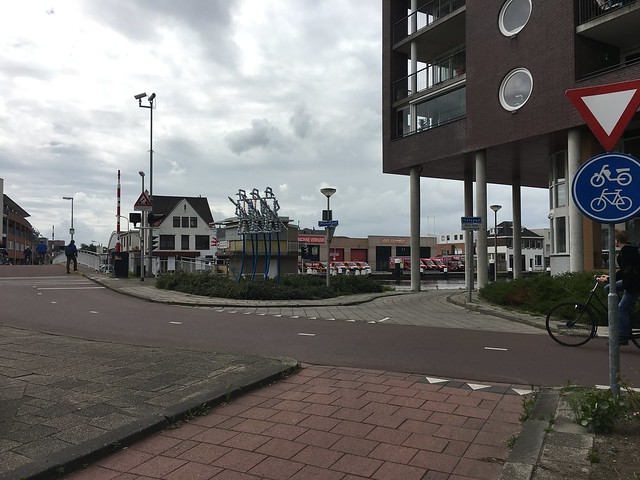
https://goo.gl/maps/gYLv4NKhv4p
Bike Path
Material: Black Asphalt
Of course, there are exceptions to every rule. In the Netherlands, red ground means bikes. But when there are no cars or people around to disrupt or interact with bikers, bike paths are created with black asphalt because it is cheaper and there isn’t a need for making it red, since no car-bike collisions could occur. The example show is of a bike path along a section of Buitenwatersloot that is too thin for cars. Because there are no cars on this area, there is no confusion about who can ride on the path since it is just for bikers.

